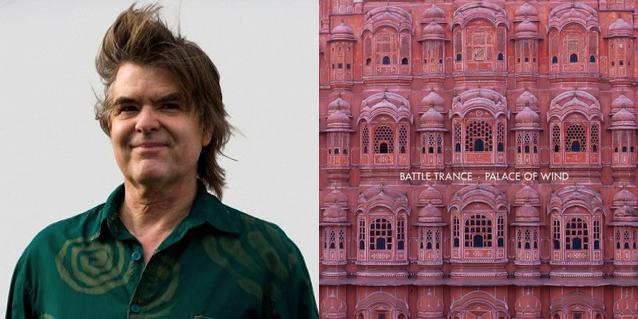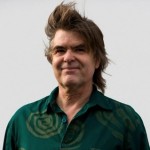Battle Trance is a saxophone quartet: four tenor saxophones to be precise. This could cause anxiety. But once you settle into their hypnotic swirl, anxiety is gone (except for those moments when it’s a deliberate part of the composition).
It’s a Palace of Wind because it is the musicians’ breath that moves that air in their horns, causing it to transform, to build into something beautiful, based on the structure of the composition. And there’s lots of breath being used — in fact, they use circular breathing techniques — but no breath is wasted here. Within its intentionally limited instrumentation, this music moves as one entity, changing and building in a very coherent fashion. While the music has an improvisatory feel, it is in fact tightly orchestrated; durations and tempos may vary from performance to performance, but otherwise it is through-composed. (You can listen to the entire piece here.)
Since they’re all tenor saxes, it would take many listens to pick out the individual players — this is very much an ensemble sound. And that’s fitting — the phrase “battle trance” refers to a phenomenon of war in which community overwhelms individuality, sacrifice of the one for the whole. It’s the cloud that Battle Trance creates that matters: rarely does a specific line override the others. It is four horn players in a room, transcending the genre.
At times the music seems to take distant cues from Steve Reich, but perhaps it’s really more akin to Terry Riley, whose loop pieces were essentially an ensemble created out of one instrument.
Palace of Wind rarely generates anything resembling a melody, and often the exact tempo or beat cannot be felt: the groove can definitely be abstract. But all the members seem to know precisely where they are at all times, and that they are working together for a common goal.
There are three movements in Palace of Wind. The first opens up with two quiet, reedy chords, plenty of space between them, with pitches deliberately bending. This lends a meditative tone to the proceedings. After a grand pause, the band lets loose with tight, fast, layered ensemble loop-like phrases. It’s dense but not impenetrable, tense but fluid. Pitches gradually change with an increase in tension, in a long, gradual crescendo. It feels like a swarm of some sort, some new species set loose that hasn’t existed before.
Throughout the piece, music morphs freely, yet always with purpose. Here a new tonal center ratchets up the intensity another notch, working towards some clear but unspecified goal. This is not programmatic music — it’s not giving clear-cut information. It’s up to the listener to merge with it and find what it means to them.
About two-thirds of the way into the movement all four horns abruptly hit the same pitch. It’s almost shocking, but it feels ecstatic rather than disruptive, like one has suddenly been set free. Eventually, they halt a continuous barrage of notes and begin floating chords, referring back to the piece’s calm introduction. The listener wasn’t waiting for that change but it was time for one: it simply showed up at the right time. They bring the movement to a close at pianissimo, with that reed-breath sound indigenous to the tenor sax. It is definitely a journey, internal.
The second movement begins with hypnotic repetition of a simple chordal motif. The progression gets more complex, adding new and dissonant notes. This is definitely the classic “slow” middle movement, with plenty of development, veering towards a chorale with hints of baroque harmony. But then things get wilder, more “birds in the forest”-sounding. To my ears, there is a touch of Terry Riley’s 1969 work Poppy Nogood and the Phantom Band. Things gradually morph into a new type of loop-like motif, ending on another ecstatic unison.
Floating, serrated polyphonics open up the third and final movement, giving a new feel to the “float chords” idea used throughout Palace of Wind. It’s got an appealing, almost electronic sound, maybe a bit like some of Stockhausen’s minimalist electronic pieces. Interesting pulses appear within unison notes as the movement develops, ideas within ideas. Around seven minutes in, there’s a melodic motif based off of the drone unisons of the other horns, and it feels like it could be a Middle Eastern double-reed instrument. It’s nearly unsettling, since up until now one has barely even considered the fact that one is listening to saxophones. As this melody develops, the rest of the horns return to normal tones, and we have left the mysterious territory behind. What at first seemed alien begins to sink into the composition, and again there’s an ecstatic dervish feel.
Later, a collective trilling begins and expands like a sonic cloud: there is pulse, but no precise time agreement. Cool. What sounds like a bona-fide free-blowing solo reveals itself to be based on a new chord cycle attached to the trilling drones, and the other horns soon join in the new ripping melee. From there they melt into a tight off/on pulsing. All of this shows off Battle Trance’s natural ensemble playing — they create these transformations organically and take you by surprise until you realize they’ve been working towards those transformations the whole time. The music morphs into a swarm of hornets, but eventually calms down (has night settled in?) as quiet pitches fade in and out, and Palace of Wind ends on a quiet sustained chord. We have returned to our starting point, somewhere in each listener’s center.
This is Battle Trance’s first album and they are definitely onto something. I have not heard saxophones, especially tenors, set into motion quite this way. The individual players are submerged into the greater whole, and there were moments when I felt the word ‘mystical’ really was an accurate description. There is so much energy here. The newness of Palace of Wind lies in the order and structure that contains that energy, and allows it to burst forth into your mind’s sky.








